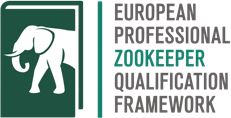Zoos have to provide a high standard of accommodation for all the animals in their care, both on-show and off-show, permanent and temporary. Accommodation must take account of the welfare of the species, their space and social needs, appropriate and efficient management by staff and appropriate display to the public. Animals are the most important stakeholder; zookeepers are their voice in the enclosure design process and must have a thorough understanding of animal welfare needs. Within this topic there are three competencies:
- Stakeholders: zookeepers can identify the key stakeholder groups involved in enclosure design.
- Enclosure Safety: zookeepers can work according to the safety requirements of the enclosure and to take into consideration the importance of barriers.
- Habitat Design: zookeepers can understand all the components that are required to suitably accommodate the animals in their care.
| Zookeepers working at Competent level can: | Zookeepers working at Proficient level can: | Zookeepers working at Expert level can: | |
|---|---|---|---|
| 3.1.1 Stakeholders | Identify key stakeholder groups involved in enclosure design, including animals, visitors, zoo management, veterinarians, the zookeepers themselves, and, if applicable, legislative bodies Explain the reason why these groups are considered stakeholders |
Describe the most important needs of each stakeholder group with regard to enclosure design (e.g. visitor needs: viewing windows, accessible paths, etc.) Assess the strengths and weaknesses of different enclosure designs from the point of view of each stakeholder group |
Analyse how an enclosure meets the needs of stakeholders and make recommendations for improvements based on that analysis Incorporate training and enrichment needs into enclosure design (e.g. by provision of a training wall) |
| 3.1.2 Enclosure Safety | Describe different types of security measures used in enclosures (including different types of barriers, doors, locks, flaps, etc.) Maintain security measures according to existing protocols |
Identify (bio)hazards connected to the enclosure design Apply their knowledge to resolve identified safety-related problems |
Implement safety measures in enclosure design (including barriers) and carry out appropriate risk assessments |
| 3.1.3 Habitat design | List common types of enclosures and identify for which species these enclosures would be suitable Identify the main components of animal enclosures (e.g. on-show and off-show accommodation, quarantine sections, etc.) Name appropriate furnishings for the species that they work with regularly (e.g. rocks, suitable planting, substrate, etc.) Describe situations where special considerations are needed (e.g. mixed species exhibits, special climate needs, etc.) |
Apply their knowledge regarding enclosure components and furnishings to assess the enclosure(s) that they are working with and propose simple improvements or modifications to the furnishing of an enclosure | Design a completely new or refurbished habitat Analyse the ways in which the habitat is used by the animals living in it and integrate their findings into future plans |
Resources
- EAZA Standards for the Accommodation and Care of Animals in Zoos and Aquaria – EAZA
- Handbook DMZAA Unit 5: Enclosure Design & Maintenance in Zoos & Aquariums – Sparsholt College
- EU Zoos Directive Good Practices Document (chapter 2.4) – European Commission
- …
Paths to fulfilment
- EAZA Academy Course ‘Exhibit Design and Planning’ – EAZA
- Diploma in Management of Zoos and Aquariums Animals (DMZAA) – Sparsholt College
- …
Last updated: 14/12/2017
